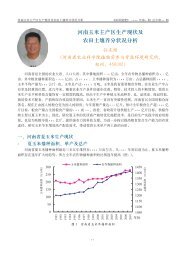Americas and Oceania Group - International Plant Nutrition Institute
Americas and Oceania Group - International Plant Nutrition Institute
Americas and Oceania Group - International Plant Nutrition Institute
Create successful ePaper yourself
Turn your PDF publications into a flip-book with our unique Google optimized e-Paper software.
<strong>Americas</strong> <strong>and</strong> <strong>Oceania</strong> <strong>Group</strong><br />
Mexico <strong>and</strong> Central America: Dr. Arm<strong>and</strong>o Tasistro<br />
Global Maize Project in Mexico: Celaya, Guanajuato<br />
Project Leader: Roberto Paredes, Instituto Nacional de Investigaciones Forestales, Agrícolas y Pecuarias (INIFAP),<br />
Colonia Roque Celaya, Guanajuato. E-mail: rparedesm59@prodigy.net.mx, paredes.roberto@inifap.gob.mx<br />
Project Cooperator: Benjamin Zamudio<br />
The study started in 2009 in Celaya, State of Guanajuato, Mexico, at 1,830 meters above sea level. The<br />
treatment design included a combination of two management systems (plant populations) (Farmers’ practice<br />
[FP] <strong>and</strong> a higher population [EI]) <strong>and</strong> three N fertilization regimes (0-N, 300 kg N/ha applied two out of<br />
three years, <strong>and</strong> 300 kg N/ha applied every year). In 2011, the six treatments were: 1) 120,192 seeds/ha, 0-N;<br />
2) 120,192 seeds/ha, 300 kg N/ha (0 N in 2009; 300 kg N/ha in 2010); 3) 120,192 seeds/ha, 300 kg N/ha (300<br />
kg N/ha applied both in 2009 <strong>and</strong> 2010); 4) 90,580 seeds/ha, 0-N; 5) 2) 90,580 seeds/ha, 300 kg N/ha (0-N in<br />
2009; 300 kg N/ha in 2010); 6) 90,580 seeds/ha, 300 kg N/ha (300 kg N/ha applied both in 2009 <strong>and</strong> 2010).<br />
The first three treatments are considered as an intensification of the last three, which represent the traditional<br />
farmers’ practice.<br />
Yields responded to N, regardless of its application sequence. The application of 300 kg N/ha increased<br />
grain yields from an average of 1.9 t/ha to 10.9 t/ha, a reflection of significantly greater Harvest Index, more<br />
ears/ha, <strong>and</strong> larger ears with heavier kernels. Partial Factor Productivity <strong>and</strong> Agronomic Efficiency were 36<br />
<strong>and</strong> 30 kg grain/kg N, respectively. No significant differences in grain yield could be detected between the<br />
intensive <strong>and</strong> traditional management options, although plant population at harvest differed significantly<br />
between them: 91,600 vs. 68,900 plants/ha, respectively. By harvest time, the plant population under both<br />
management systems had decreased by 24% on average, which is higher than normal, especially under<br />
experimental conditions. Most of that loss (15%) had taken place by the third week after crop planting.<br />
IPNI-28<br />
Global Maize Project in Mexico: Toluca, México<br />
Project Leader: Benjamín Zamudio, González Instituto Nacional de Investigaciones Forestales, Agrícolas y Pecuarias<br />
(INIFAP), Toluca, México. E-mail: zamudio.benjamin@inifap.gob.mx<br />
The study was started in 2009 in Toluca, State of México, at an altitude of 2,370 meters above sea level.<br />
The objective was to compare the effects of six combinations of plant populations <strong>and</strong> fertilizer applications.<br />
Half of the treatments—labeled as intensive management—included high plant populations <strong>and</strong> the<br />
application of a complete fertilizer formula (90 kg P 2 O 5 /ha, 90 kg K 2 O/ha, 44 kg MgO/ha, 50 kg S/ha, <strong>and</strong><br />
3 kg Zn/ha). The other half of the treatments were similar to current farmers’ practices with regards to plant<br />
population <strong>and</strong> fertilizer application (30 kg P 2 O 5 /ha <strong>and</strong> 30 kg K 2 O/ha). Three N fertilizer application regimes<br />
were combined with the management systems just described: 0-N, 300 kg N/ha applied two out of three<br />
years, <strong>and</strong> 300 kg N/ha applied every year with the intensive management, <strong>and</strong> 0-N, 180 kg N/ha applied two<br />
out of three years, <strong>and</strong> 180 kg N/ha applied every year, with the farmers’ management.<br />
The 2011 season was very bad, with lack of rain at the beginning; followed by flooding, hail storms,<br />
<strong>and</strong> a devastating early frost in the first week of September. The yield levels were therefore lower than in<br />
the previous years. Yield under intensive management (3,594 kg/ha) was significantly higher than under<br />
traditional management (2,699 kg/ha). This result mirrored the differences in plant population at harvest:<br />
80,208 <strong>and</strong> 62,691 plants/ha in the intensive <strong>and</strong> farmers’ management treatments, respectively. Under<br />
intensive management, yields with N (3,906 kg/ha) were 31% higher than without N (2,971 kg/ha), whereas<br />
no significant effects from N could be detected under the traditional management. Partial Factor Productivity<br />
IPNI Interpretive Summaries 43

















